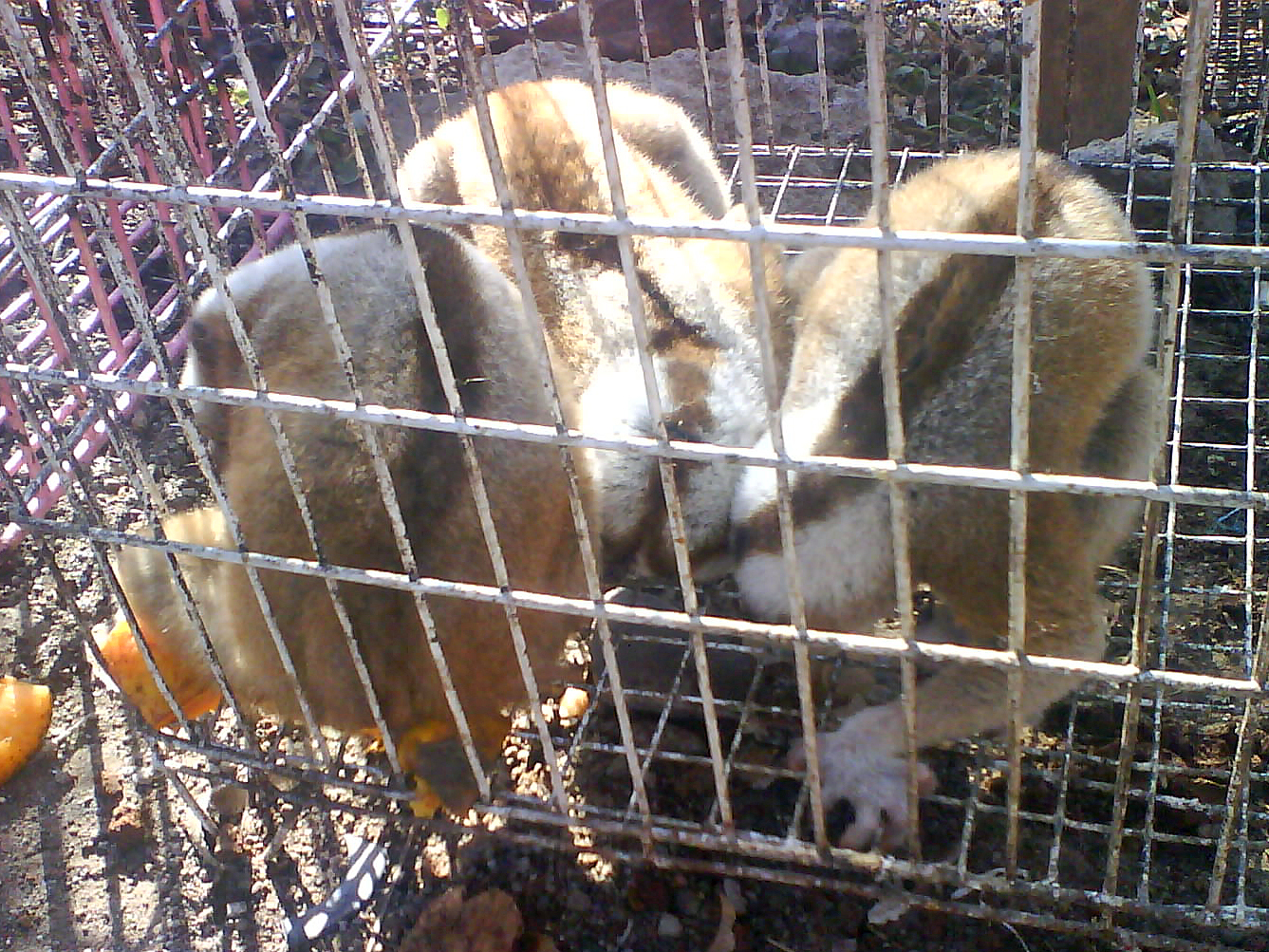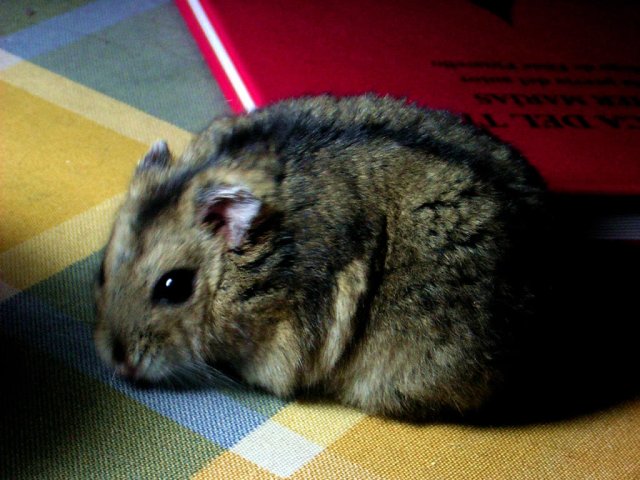|
Emin's Pouched Rat
Emin's pouched rat ''(Cricetomys emini)'', also known as the African pouched rat, is a large rat of the muroid superfamily. It is related to ''Cricetomys gambianus'', the Gambian pouched rat. Both species belong to '' Cricetomys'', the genus of the giant pouched rats. These animals were introduced into the exotic pet trade, but have been banned by the CDC and FDA after an outbreak of monkeypox. They are easily tamed. Comparison to Gambian pouched rats They are native to Africa and are found along the edges of forests and along the plains. Emin's pouched rats are actually better climbers than their better known Gambian pouched rat cousins. These pouched rats are named for having cheek pouches much like a hamster. Emin's pouched rat and the Gambian pouched rat have a few very noticeable physical differences: *Emin's pouched rats have a distinct line of color difference between their lower abdomen area and upper body. The abdomen is grey/white, whereas their upper body is da ... [...More Info...] [...Related Items...] OR: [Wikipedia] [Google] [Baidu] |
Muroid
The Muroidea are a large superfamily of rodents, including mice, rats, voles, hamsters, lemmings, gerbils, and many other relatives. Although the Muroidea originated in Eurasia, they occupy a vast variety of habitats on every continent except Antarctica. Some authorities have placed all members of this group into a single family, Muridae, due to difficulties in determining how the subfamilies are related to one another. Many of the families within the Muroidea superfamily have more variations between the families than between the different clades. A possible explanation for the variations in rodents is because of the location of these rodents; these changes could have been due to radiation or the overall environment they migrated to or originated in. The following taxonomy is based on recent well-supported molecular phylogenies. The muroids are classified in six families, 19 subfamilies, around 280 genera, and at least 1,750 species. Taxonomy *Family Platacanthomyidae (spiny ... [...More Info...] [...Related Items...] OR: [Wikipedia] [Google] [Baidu] |
Gambian Pouched Rat
The Gambian pouched rat (''Cricetomys gambianus''), also Common name, commonly known as the African giant pouched rat, is a species of nocturnal pouched rat of the giant pouched rat genus ''Cricetomys'', in the Family (biology), family Nesomyidae. It is among the largest Muroidea, muroids in the world, growing to about long, including the tail, which makes up half of its total length. It is widespread in Sub-Saharan Africa, ranging from Senegal to Kenya and from Angola to Mozambique (although it is absent from much of the Democratic Republic of the Congo, where Emin's Pouched Rat, Emin's pouched rat is present) from sea level to . The Gambian pouched rat is sometimes kept as a pet, but some have escaped from captivity and become an invasive species in Florida. In the United States, the Centers for Disease Control and Prevention (CDC) and the Food and Drug Administration (FDA) now ban the importation of this species because it is blamed for the 2003 Midwest monkeypox outbreak, 200 ... [...More Info...] [...Related Items...] OR: [Wikipedia] [Google] [Baidu] |
Exotic Pet
An exotic pet is a pet which is relatively rare or unusual to keep, or is generally thought of as a wild species rather than as a domesticated pet. The definition varies by culture, location, and over time—as animals become firmly enough established in the world of animal fancy, they may no longer be considered ''exotic''. Definitions The definition is an evolving one; some rodents, reptiles, and amphibians have become firmly enough established in the world of animal fancy to no longer be considered exotic. Sometimes any unique or wild-looking pet (including common domestic animals such as the ferret and the rat) is considered an exotic pet. "Exotic" often refers to a species which is not native or indigenous to the owner's locale, and "pet" is a companion animal living with people. However, many use the term to include native species as well (e.g., snakes may sometimes be considered exotic as pets even in places where they are found in the wild). The international organi ... [...More Info...] [...Related Items...] OR: [Wikipedia] [Google] [Baidu] |
Africa
Africa is the world's second-largest and second-most populous continent, after Asia in both cases. At about 30.3 million km2 (11.7 million square miles) including adjacent islands, it covers 6% of Earth's total surface area and 20% of its land area.Sayre, April Pulley (1999), ''Africa'', Twenty-First Century Books. . With billion people as of , it accounts for about of the world's human population. Africa's population is the youngest amongst all the continents; the median age in 2012 was 19.7, when the worldwide median age was 30.4. Despite a wide range of natural resources, Africa is the least wealthy continent per capita and second-least wealthy by total wealth, behind Oceania. Scholars have attributed this to different factors including geography, climate, tribalism, colonialism, the Cold War, neocolonialism, lack of democracy, and corruption. Despite this low concentration of wealth, recent economic expansion and the large and young population make Afr ... [...More Info...] [...Related Items...] OR: [Wikipedia] [Google] [Baidu] |
Hamster
Hamsters are rodents (order Rodentia) belonging to the subfamily Cricetinae, which contains 19 species classified in seven genera.Fox, Sue. 2006. ''Hamsters''. T.F.H. Publications Inc. They have become established as popular small pets. The best-known species of hamster is the golden or Syrian hamster (''Mesocricetus auratus''), which is the type most commonly kept as pets. Other hamster species commonly kept as pets are the three species of dwarf hamster, Campbell's dwarf hamster (''Phodopus campbelli''), the winter white dwarf hamster (''Phodopus sungorus'') and the Roborovski hamster (''Phodopus roborovskii''). Hamsters are more crepuscular than nocturnal and, in the wild, remain underground during the day to avoid being caught by predators. They feed primarily on seeds, fruits, and vegetation, and will occasionally eat burrowing insects. Physically, they are stout-bodied with distinguishing features that include elongated cheek pouches extending to their shoulders, which ... [...More Info...] [...Related Items...] OR: [Wikipedia] [Google] [Baidu] |
Abdomen
The abdomen (colloquially called the belly, tummy, midriff, tucky or stomach) is the part of the body between the thorax (chest) and pelvis, in humans and in other vertebrates. The abdomen is the front part of the abdominal segment of the torso. The area occupied by the abdomen is called the abdominal cavity. In arthropods it is the posterior (anatomy), posterior tagma (biology), tagma of the body; it follows the thorax or cephalothorax. In humans, the abdomen stretches from the thorax at the thoracic diaphragm to the pelvis at the pelvic brim. The pelvic brim stretches from the lumbosacral joint (the intervertebral disc between Lumbar vertebrae, L5 and Vertebra#Sacrum, S1) to the pubic symphysis and is the edge of the pelvic inlet. The space above this inlet and under the thoracic diaphragm is termed the abdominal cavity. The boundary of the abdominal cavity is the abdominal wall in the front and the peritoneal surface at the rear. In vertebrates, the abdomen is a large body c ... [...More Info...] [...Related Items...] OR: [Wikipedia] [Google] [Baidu] |
Cricetomys Emini
Emin's pouched rat ''(Cricetomys emini)'', also known as the African pouched rat, is a large rat of the muroid superfamily. It is related to ''Cricetomys gambianus'', the Gambian pouched rat. Both species belong to '' Cricetomys'', the genus of the giant pouched rats. These animals were introduced into the exotic pet trade, but have been banned by the CDC and FDA after an outbreak of monkeypox. They are easily tamed. Comparison to Gambian pouched rats They are native to Africa and are found along the edges of forests and along the plains. Emin's pouched rats are actually better climbers than their better known Gambian pouched rat cousins. These pouched rats are named for having cheek pouches much like a hamster. Emin's pouched rat and the Gambian pouched rat have a few very noticeable physical differences: *Emin's pouched rats have a distinct line of color difference between their lower abdomen The abdomen (colloquially called the belly, tummy, midriff, tucky or stom ... [...More Info...] [...Related Items...] OR: [Wikipedia] [Google] [Baidu] |
Rodents Of Africa
Rodents (from Latin , 'to gnaw') are mammals of the order Rodentia (), which are characterized by a single pair of continuously growing incisors in each of the upper and lower jaws. About 40% of all mammal species are rodents. They are native to all major land masses except for New Zealand, Antarctica, and several oceanic islands, though they have subsequently been introduced to most of these land masses by human activity. Rodents are extremely diverse in their ecology and lifestyles and can be found in almost every terrestrial habitat, including human-made environments. Species can be arboreal, fossorial (burrowing), saltatorial/richochetal (leaping on their hind legs), or semiaquatic. However, all rodents share several morphological features, including having only a single upper and lower pair of ever-growing incisors. Well-known rodents include mice, rats, squirrels, prairie dogs, porcupines, beavers, guinea pigs, and hamsters. Rabbits, hares, and pikas, whose incisors ... [...More Info...] [...Related Items...] OR: [Wikipedia] [Google] [Baidu] |





